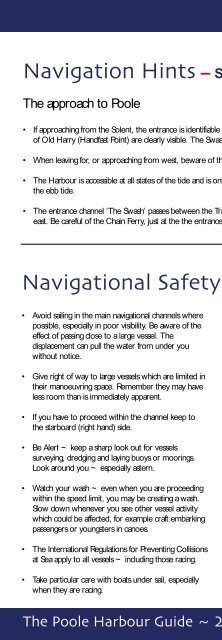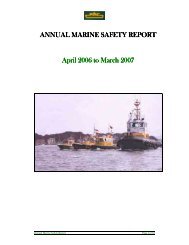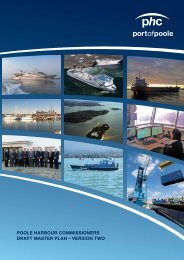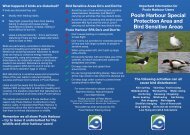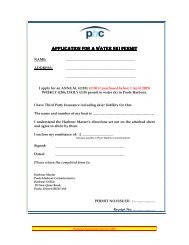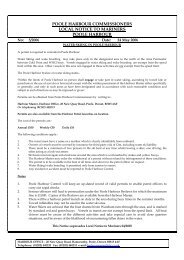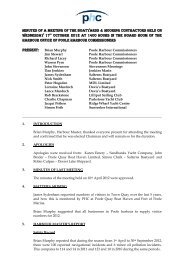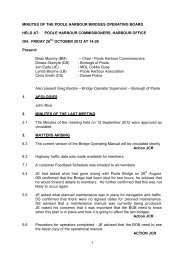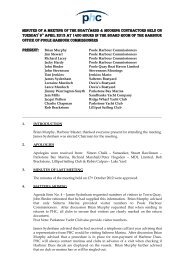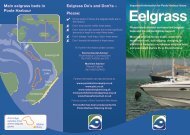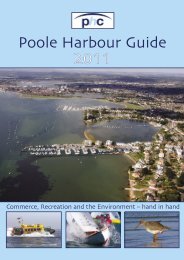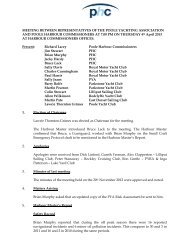The Poole Harbour Guide 2012 - Poole Harbour Commissioners
The Poole Harbour Guide 2012 - Poole Harbour Commissioners
The Poole Harbour Guide 2012 - Poole Harbour Commissioners
You also want an ePaper? Increase the reach of your titles
YUMPU automatically turns print PDFs into web optimized ePapers that Google loves.
Navigation Hints – See Admiralty Chart 2611<br />
<strong>The</strong> approach to <strong>Poole</strong><br />
• If approaching from the Solent, the entrance is identifiable from the high cliffs of Anvil Point. When nearer, the rocks<br />
of Old Harry (Handfast Point) are clearly visible. <strong>The</strong> Swash Channel is clearly marked.<br />
• When leaving for, or approaching from west, beware of the race off Handfast Point on the ebb tide.<br />
• <strong>The</strong> <strong>Harbour</strong> is accessible at all states of the tide and is only dangerous in very strong S and SE winds, particularly on<br />
the ebb tide.<br />
• <strong>The</strong> entrance channel ‘<strong>The</strong> Swash’ passes between the Training Bank, on the western side, and Hook Sands to the<br />
east. Be careful of the Chain Ferry, just at the the entrance, as the ebb can run at 3 to 4 knots.<br />
Navigational Safety Guidance<br />
• Avoid sailing in the main navigational channels where<br />
possible, especially in poor visibility. Be aware of the<br />
effect of passing close to a large vessel. <strong>The</strong><br />
displacement can pull the water from under you<br />
without notice.<br />
• Give right of way to large vessels which are limited in<br />
their manoeuvring space. Remember they may have<br />
less room than is immediately apparent.<br />
• If you have to proceed within the channel keep to<br />
the starboard (right hand) side.<br />
• Be Alert ~ keep a sharp look out for vessels<br />
surveying, dredging and laying buoys or moorings.<br />
Look around you ~ especially astern.<br />
• Watch your wash ~ even when you are proceeding<br />
within the speed limit, you may be creating a wash.<br />
Slow down whenever you see other vessel activity<br />
which could be affected, for example craft embarking<br />
passengers or youngsters in canoes.<br />
• <strong>The</strong> International Regulations for Preventing Collisions<br />
at Sea apply to all vessels ~ including those racing.<br />
• Take particular care with boats under sail, especially<br />
when they are racing.<br />
<strong>The</strong> <strong>Poole</strong> <strong>Harbour</strong> <strong>Guide</strong> ~ <strong>2012</strong><br />
• Be visible and make your intentions clear. You may<br />
think you know what you are doing and where you<br />
are going, but put yourself in the shoes of the Master<br />
of the cross channel ferry ~ does he know?<br />
• You may see a large ship at all times, but if you<br />
disappear from the view of the Master of that ship<br />
you are too close,<br />
• Do not underestimate the speed of other ships. If<br />
your boat is slow you might not be able to take<br />
effective action to keep clear if you find yourself on a<br />
collision course. If in doubt, take avoiding action and<br />
take it early.<br />
• Do not anchor or drift in any navigational channel or<br />
create an obstruction within the channels.<br />
• Do not secure to, or obscure any navigational marks.<br />
buoy, beacon or stake.<br />
• Mariners are advised that large inbound vessels will<br />
tend to be on the port hand side of the channel<br />
between the <strong>Harbour</strong> Entrance and North Haven<br />
Point to avoid Chapmans Peak.


